Balenciaga
See it »
<span>The designer’s contemplative, cadaverous fall 2016 collection is deeply satisfying. </span>
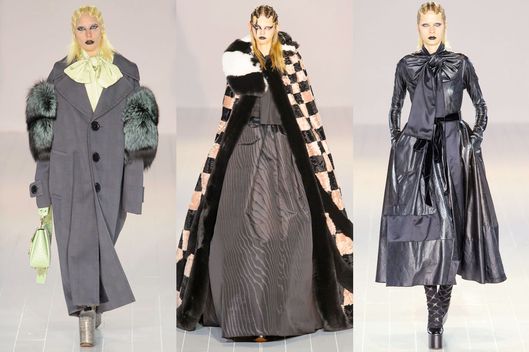
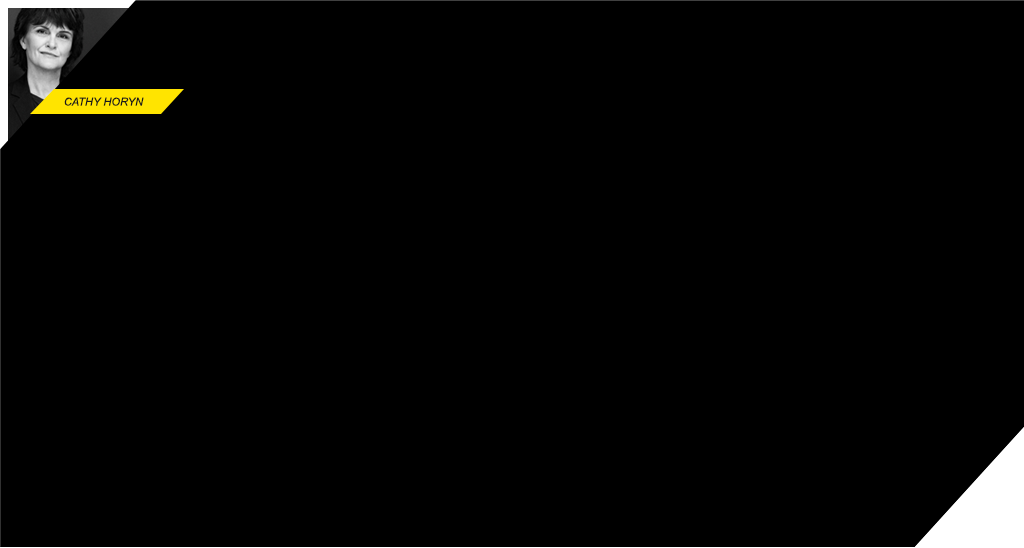
The faster the world moves, the more some designers want to slow its orbit. The set for Marc Jacobs’s show last night, at the Park Avenue Armory, was an open circle — large, unobstructed, bright white. It seemed more breathing space than void, and because it was round, it represented, to me, a fundamental life pattern: What goes around … the eternal return of the same …
But maybe because of the huge shadows cast by the models on the back wall as they entered the open space, I saw them as ghosts, and Jacobs’s collection as an expression of the way history remains as a trace. This is especially true of clothing, with its stock of human associations and, literally, body impressions. The Paris costume curator Olivier Saillard made this point in the performance pieces he did with Tilda Swinton a couple of years ago in Paris, in which she used gestures and words to relate historical garments to the figures who had once worn them.
Even though Jacobs’s show contained many historical shapes — silk robes and visiting dresses that might have been from around 1900, full skirts from the ’50s, poufy ball gowns and furs from the glitzy ’80s — it was no more a trip down memory lane than Saillard’s pieces were. If anything, the Jacobs show was a plea to step away from the runway rat race and Instagram hustle, and take time to seriously consider things. A possible clue to his intentions was the lack of music: the models, on towering platforms, walked just to the chime of single, irregularly repeated bell tones. The shoes were another clue. Not only did they make already tall women seem ridiculously tall, but they also made them seem quite wispy, as if they might blow away. With their raccoon eyes and 1920s finger waves, the girls looked like a cross between Edward Gorey figures and the eccentric Italian heiress Luisa, Marchesa Casati, who loved a cadaverous look. (Indeed, some of the full black skirts had black cats on them that suggested Gorey. And a smudgy hand-print pattern in gray added to the ghostly vibe.)
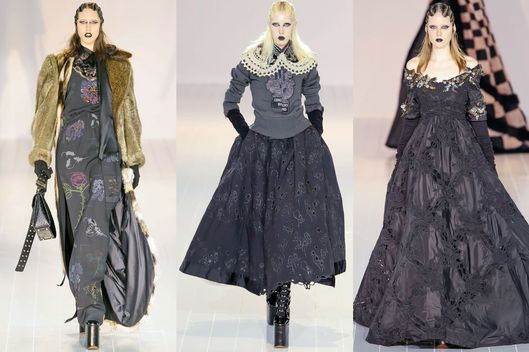
Another thing that struck me was the number of grand-looking clothes. Some, as I say, had overtones of the Edwardian era, others the ’80s in New York — a period associated with the Basses, Gutfreunds, Kravitzes, the lavish designs of Ungaro and Oscar de la Renta, and of course captured in The Bonfire of the Vanities. Those eras, though, were about power and greatness — great wealth and ambition but also a swaggering claim on the future. Masters of the Universe. Viewed in the calm of the Armory, the silhouettes of dresses seemed what mostly remains of that greatness. A new generation now sets the tone.
Sometimes I think a Jacobs show can get a bit old-clothesy. I felt that way a year ago about his ode to Diana Vreeland. Dreary me! But this time, in spite of the many vintage shapes, I didn’t have that impression. I thought Jacobs was relying more on his feelings, on ideas and images that have been stored in his mind for years, and which he wanted to selectively relate to the present — above all, perhaps, to our topsy-turvy sense of time.
And he began this collection so modestly, too. “I started with an oversize sweatshirt,” he said backstage. “And that led to …” In short, to a deeply satisfying experience.
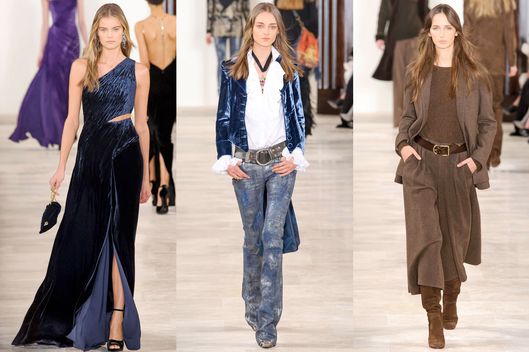
Hoping that Ralph Lauren might change up his idyllic American style, even just a little, won’t get you very far. The opening tweeds and cashmere sweaters (this season in taupe and truffle-brown with a drop of olive and loden) were determinately the same as in seasons past. Jewel-tone evening dresses in matte velvet were lovely, and I’m a sucker for an 18th-century ruffled cotton shirt. But maybe the time has come for Lauren to shake up the formula of both the presentations and the low-key classics.
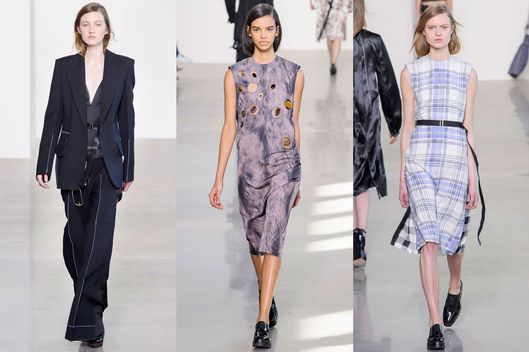
Ornament got the better of Francisco Costa’s show for Calvin Klein. First it was leather suspenders and black harness belts that added clutter to fairly sleek black trouser suits, and then it was smooth pieces of stone inset (by means of thin metal frames) into long silk dresses. Rock hounds can understand the appeal of organic materials, but on a cocktail dress? The idea needed more thought, or should have been skipped altogether. My favorite bit in the show was a handful of silk shifts and long-sleeve dresses in contrasting plaids and checks on a white background. They were a quick wink at grunge, and I wish Costa had kept the rest of the collection as light and unexpected.
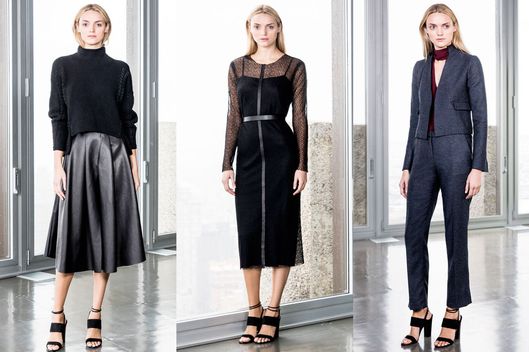
Jeffrey Dodd is a new designer, in his third season, but his elegant, modest sportswear merits attention. Dodd, who formerly worked as an assistant at Rachel Zoe and as a merchandiser at Ralph Lauren, focuses on tailoring in soft menswear fabrics, but in a way his strength is the simple gesture that gives a maximal effect, like a spare black evening column overlaid with close-fitting black point d’esprit (with the arms covered, too), or a navy hand-knitted sailing sweater, whip-stitched with tiny black leather cord, and worn with a jaunty black leather skirt. His repertoire is small, for now, but the grace notes are strong.
To be fair, it was a 13 foot-long dress.
You and Rihanna Will Both Want to Invest in Dior’s New BagIt's got something for everyone.
Polo Shirts Have Turned Their Back on Ryan LochteAlong with his other major sponsors.
Ryan Lochte Will No Longer Be Paid to Wear Tiny Bathing SuitsSpeedo remains committed to transparency.
Laura Brown Is the New Editor-in-Chief of InStyleAfter 11 years at Harper’s Bazaar.
Tyra Banks Is Going to Teach a Class on Smizing at Stanford"If I see somebody not paying attention, I’m gonna call on them."
This Floating Pier Is the Most Zen Installation EverWalking on water in Italy.
Nation Is Appalled by Matt Lauer’s Nude Ankles During Ryan Lochte InterviewWhat’s the opposite of “Jeah”?
8 People at the Life of Pablo Pop-up Explain Why Kanye West Is a God"I mean, Kanye West is just Kanye West. There's not more or less you can say about Kanye West. He's just Mr. West!"
A T-shirt Is EnoughSimplicity, versatility, and cool. What more could you want?
She took a perfect pencil dive off a 30-foot yacht.
American Apparel Is Being Sued by Former WorkersAs the company considers putting itself up for sale.
A Gendered History of the Tailored SuitFrom Marlon Brando to Coco Chanel.
How Zendaya Developed Such Great Style at the Young Age of 19The star's best looks from Disney to now.
Proof That If You’re Chic Enough, a Little Federal Investigation Doesn’t MatterIs this the best they could do?
5,300-Year-Old Mummified Iceman Probably Would’ve Been a Street-Style StarHe had several different looks and was “pretty picky.”
J.Crew Has Identified 226 Shades of PinkEven more than there are shades of gray.
Gigi and Bella Hadid Merch Is Now Somehow a Thing That Is HappeningToday in Hadidiana.
Gird Your Loins for the Return of Yeezy to New York Fashion WeekThe season approaches.
This Indie Brand Had a Great Response to Ivanka TrumpWhen she bought one of their cuffs, they donated the proceeds to the Clinton campaign.